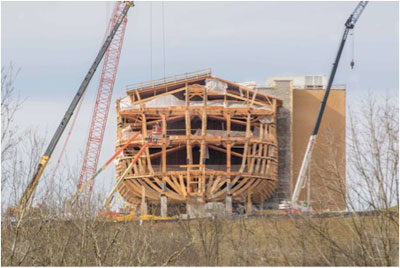
Accoya Acetylated Wood is one building product we’re keeping an eye on this year. Named as one of the top 10 green building products for 2017, the product is tipped to have a significant impact on the market in the coming years. Source: Architecture And Design
While the product is available in Australia through Britton Timbers , M&B Building Products and Matthews Timber, it has not been used to the extent we’ve seen overseas.
Accoya is an American high-performance natural wood product made from sustainably grown Radiata Pine from New Zealand and Chile which has been modified in a process called acetylation.
Acetylation increases the amount of naturally occurring acetyl molecules in timber, which improves its durability, stability, and service life.
It has been thoroughly tested for dimensional stability, durability, paint retention and inground conditions, and has been used by architects all over the world for a variety of applications.
It is ideal for exterior applications such as windows, doors, siding, decking and outdoor furniture. Inspiration: we have listed six projects from around the globe have made use of the Accoya product.
Located within the Naturarena Rotsee rowing development in Lucerne, the rowing centre designed by Andreas Fuhrimann Gabrielle Hächler Architekten is a three-storey prefabricated wood construction carried above the water level by a concrete platform.
The centre was clad with Accoya to both reflect the natural woodland surroundings, and to form a façade able to cope with extreme conditions.
Swiss distributers Herzog-Elmiger AG recommended Accoya for the project, citing the woods high resistance to water.
For the finished centre, 1700sqm of Accoya, which is 100% non-toxic, was prefabricated to form the building’s façade and decking.
The wood was applied with a Sikkens coating to integrate the façade with the overall colour concept.
In 2015, RO&AD Architecten were tasked with making a kiosk with public toilets and an information point at the site of the only remaining Ravelijn in The Netherlands.
Apart from the brick foundation, the entire kiosk is made from Accoya.
Today, the site is mainly used for small public and private events.
An RIBA award-winning four-bedroom home designed by LSI Architects has combatted its Flood Zone 3 location and its constant exposure to moisture with Accoya.
The product was used for the Norfolk home’s cladding, decking and sculptural entrance screen to the rear because it delivered durability, dimensional stability and aesthetics.
Glue laminated Accoya was also used for the curved rear screen and hand finished with a protective merbau-coloured coating from Wood Guard by Guard Industrie. The same finish was factory applied to the cladding.
Accoya was chosen for Studio MK27’s Jungle House (Casa da Mata) on Guarujá Beach due to its durability to withstand Brazil’s intense heat and humidity.
The product was used for the home’s decking, facades, and for some of the interior panelling and room furniture.
Additionally, Accoya was used for the home’s MUXARABI joineries. This special type of joinery is used by architects to enhance the aesthetic designs of projects.
In the instance of Jungle House, the joinery acts as a light filter, providing varying projections of light as the sun moves around the house throughout the day.
No colour was applied to the wood, leaving it in its natural grey state which compliments the surroundings of the project.
The Royal Arena in Copenhagen, which opened this month, has utilised Accoya for its entire façade.
The wood was selected by architects 3XN for the arena’s fins due to its elegant aesthetic appearance which gives the building an eye-catching and bespoke style.
They were also chosen due to its durability and worldwide environmental standards.
“Durability and aesthetics were key issues driving the material selection for the fins on the new Royal Arena in Copenhagen,” Jan Ammundesen, senior partner at 3XN said.
“The Accoya fins will create a dynamic pattern and contribute to a warm and natural appearance of the façade.”
The historical theme park by Leroy Troyer is a replica of Noah’s ark described in the Bible – 155 metres long and 24 metres high, making it the largest free standing timber structure in the world.
Accoya was chosen for the exterior cladding because of its dimensional stability. In addition, its acetylation properties prevent pests from damaging the surface and ruining the aesthetics of the structure.
“We were impressed with Accoya’s credentials – the product is fully carbon neutral, extremely durable in exterior applications and both reusable and recyclable,” Todd Geer, Leroy Troyer said. “Accoya has been recognised for its environmental standards worldwide so we were very interested in using Accoya to build the country’s very own Noah’s Ark.”





